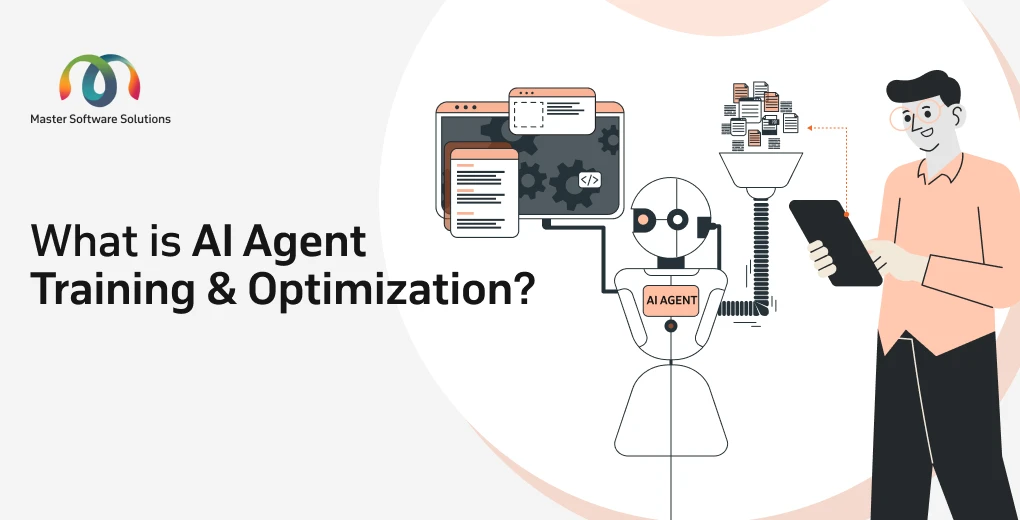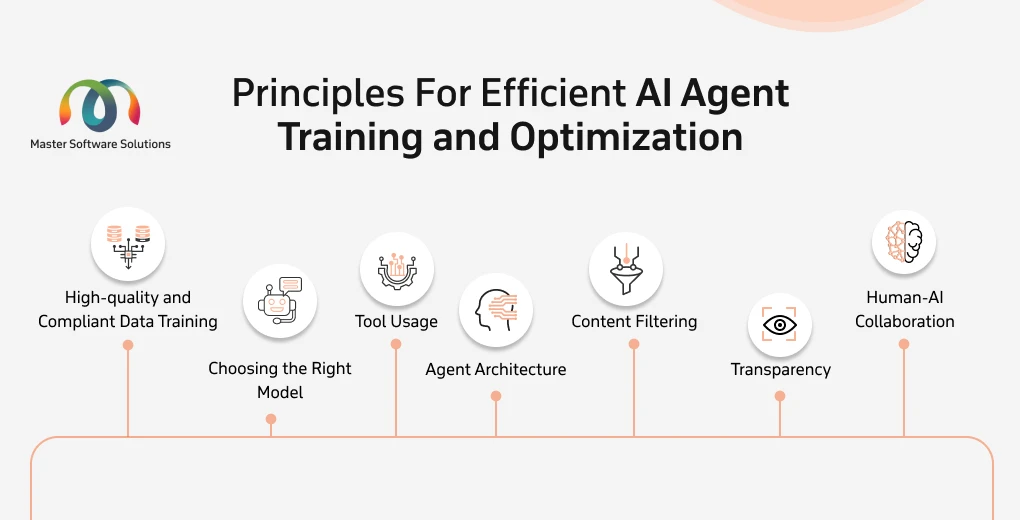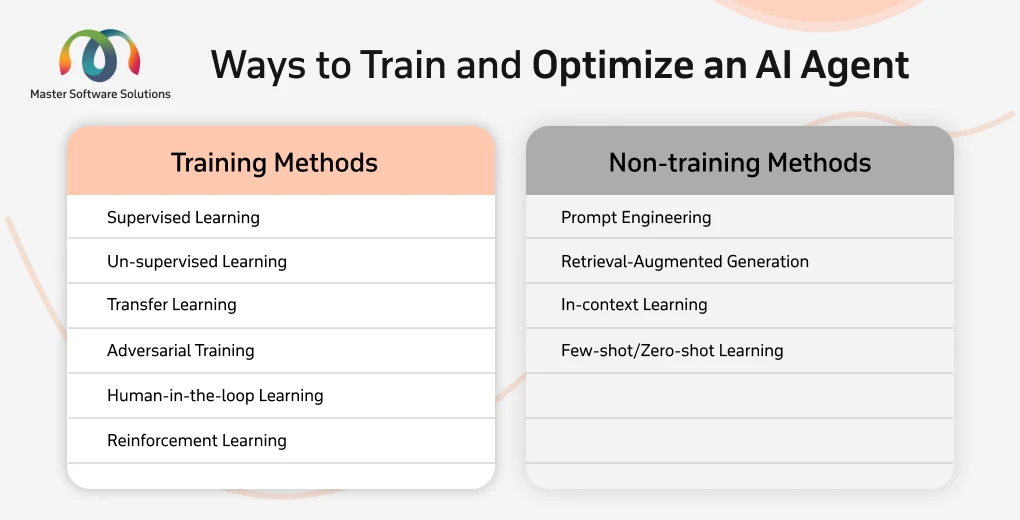AI agents are continuously transforming business operations with their autonomous capabilities. They can automate processes, improve decision-making, and enhance efficiency. This AI agent’s effectiveness depends on how well your agent is trained and optimized.
AI agent training and optimization is a well-structured process of teaching AI models to perform multi-step tasks, make decisions, and adapt to real-world scenarios. This blog explores the core principles of AI agent training and optimization, challenges, and best practices for reliable and scalable AI agents.
What is AI agent training?
AI agent training includes teaching your AI model to perceive its environment, process the information, and take actions to achieve business-aligned goals. It involves designing and developing an AI agent and using data to refine its performance. Process of AI agent training:
- Feed data to the agent – The agent uses data to identify patterns and relationships.
- Use ML techniques – Employ supervised, reinforcement, or unsupervised learning to train the agent.
- Iterative refinement – Evaluate the agent’s performance and adjust its parameters based on feedback for improved accuracy.
What is AI agent optimization?
AI agent optimization focuses on improving its performance and efficiency. This includes adjusting parameters, refining algorithms, or implementing new techniques to enhance the AI agent’s ability to achieve its goals effectively. AI agent optimization includes refining the agent’s internal mechanisms and strategies.
Why is AI agent training and optimization essential?
AI agents are autonomous software solutions or entities interact with their current surroundings to achieve defined goals. Their effectiveness depends on how well you train and optimize your agents. Well-trained and highly optimized AI agents can transform core business processes, automating and streamlining operations. AI training and optimization are essential for several reasons, including:
- With accurate data, training, and fine-tuning, produce relevant results and mitigate biases.
- Task-specific optimization, reinforcement learning (learning from feedback), and continuous training can improve performance and efficiency.
- Well-trained and optimized AI agents can improve user satisfaction, achieve business goals, and mitigate costs.
- Training and optimization enable you to control the AI agent’s behaviour, align it with human values and societal norms, and reduce the risk of mistakes, addressing ethical and safety concerns.
Principles for efficient AI agent training and optimization
AI agent training and optimization require a well-structured approach that can help you enhance efficiency, effectiveness, and responsible development. These core principles of training and optimization are interconnected and considered holistic throughout an AI agent’s life cycle. You can hire AI agent developers who are proficient in design, development, and training an AI agent. The core principles of AI agent training and optimization are:
High-quality and compliant data training
Feed accurate, relevant, diverse, and sufficient data for AI agent training specific business goals. The data must adhere to data privacy regulations and ethical guidelines. Implement thorough data cleaning and preprocessing pipelines. Employ data augmentation techniques to increase dataset size and diversity. Proactively incorporate feedback data to refine training sets. Establish governance policies to ensure compliance.
Choosing the right model
Select an appropriate AI model architecture to achieve optimal performance and efficiency. Different tasks and data characteristics require different model types, for example, transformer networks for NLP, convolutional neural networks for image processing, and reinforcement learning agents for decision-making.
Tool usage
Employ adequate tools and frameworks to streamline the training and optimization for improved efficiency and reproducibility. They include libraries, platforms, and infrastructure for data management, model development, training, evaluation, and deployment.
Agent architecture
Designing a well-structured and modular agent architecture is complex. You should define various AI agent components, such as perception, reasoning, action, and memory, and how they interact and collaborate.
Content filtering
Implement a content filtering process to ensure the AI agent generates safe, relevant, and appropriate outputs. This process involves identifying and mitigating harmful, biased, or irrelevant content produced during training and inference.
Transparency
Understand how AI agents work and arrive at a decision to build user trust and facilitate debugging and improvement. Providing insights into an agent’s reasoning can be valuable.
Human-AI collaboration
The AI agents are highly effective when working alongside humans. It includes designing a system where the user can provide feedback, correct errors, assist learning, and handle complex situations that the AI agents can’t.
How can you train and optimize an AI agent?
Training and optimizing an AI agent involves teaching large language models to empower agents to complete a specific task efficiently. Various techniques and approaches are available to train and optimize AI agents. The two types of training methods are training methods and non-training methods.
Training Methods
It includes exposing the AI agent to data or environments to learn patterns, relationships, and optimal behaviour.
- Supervised learning – The agent is trained on labeled datasets, and each input is paired with the desired output. Agents learn to map input to output by minimizing the difference between
- Unsupervised learning – The agent learns patterns and structures from unlabeled data. This aims to discover the hidden relationships, group similar data points, or reduce the data dimension.
- Transfer learning – This includes using knowledge gained from training agents on one task or dataset and then applying it to a different but related task to reduce the data and training time for a new task.
- Adversarial training – The agent is exposed to adversarial examples ( inputs designed to fool the model), making the model more robust and less susceptible to subtle changes in the input data.
- Human-in-the-loop (HITL) learning – The AI agent training includes integrating human feedback and guidance into the training process, where you can label data, evaluate the agent’s performance, or provide corrections.
- Reinforcement learning from human feedback (RLHF) – The AI agent learns from human preferences expressed through agent comparison or ratings.
Non-training approaches
The non-training approaches focus on guiding and utilizing pre-trained models or external knowledge without task-specific training. The non-training approaches for AI agent training and optimization are:
- Prompt engineering – Designing functional and informative prompts to guide large language models to generate desired results. This includes crafting instructions, context, examples, and input formatting.
- Retrieval-Augmented Generation (RAG) – It combines a pre-trained language model with an external knowledge retrieval mechanism. The agent retrieves relevant data from the database when it receives a query and then uses data to generate an informed and contextually accurate response.
- In-context learning – Provide demonstrations or examples within the input prompt to guide the large pre-trained model to perform a specific task without extensive fine-tuning. The AI model uses its broader knowledge and pattern recognition abilities to achieve desired results.
- Few-shot/zero-shot learning – For few-shot, the agent is given a small number of examples in the prompt to learn a new task. Zero-shot learning includes AI agents performing tasks based solely on a natural language description of the task in the prompt.
Challenges faced in AI agent training and optimization
You might face various challenges while training and optimizing AI agents. It requires a multi-faceted approach that involves advancements in data science, machine learning algorithms, computational infrastructure, ethical AI frameworks, and collaborative research efforts. These AI agent training and optimization challenges include:
Data quality and availability
You require high-quality, relevant, and diverse data, specifically when AI agents rely on supervised or reinforcement learning. Collecting, cleaning, labeling, and maintaining such datasets is challenging.
Computational resources and costs
Training complex AI models, especially those using deep learning models in AI agents, requires significant computational resources, including powerful GPUs or TPUs, a large amount of memory, and substantial energy consumption.
Ethical and bias concerns
AI agents can inherit and exaggerate biases in their training data, leading to unfair, discriminatory, or harmful outcomes.
Multi-agent coordination
Training and optimizing systems include multiple interacting AI agents, which have challenges related to coordination, communication, cooperation, and potential conflicts.
Best practices for AI agent training and optimization
Implementing the best AI agent training and optimization practices can help you improve the effectiveness, reliability, and value within a business context. The best practices you should follow while training and optimizing your AI agent are:
Align AI agents with business objectives
Your AI agent and its training and optimization must aim to solve specific business challenges. Establish key performance indicators (KPIs) to measure your AI agent’s success in achieving your objectives. You must involve stakeholders from relevant units in the design and evaluation process. Proactively revisit and adjust training and optimization strategies to ensure alignment with evolving business priorities.
Use high-quality, business-relevant data
Ensure that the data is accurate, relevant, and compliant. You should invest in data cleaning, preprocessing, and validation processes. Focus on acquiring data sources related to the agent’s domain and objectives. Implement data augmentation techniques when required to increase dataset size and diversity. Establish a robust data governance framework to ensure data quality, security, and compliance. Proactively monitor data sources for drift and update training data as needed.
Implement continuous learning and model updates
AI agents’ training and optimization should not be a static process; instead, it should have continuous monitoring, retraining, and updating of models to adapt to changing data, environments, and business needs.
Ensure transparency, fairness, and explainability
Ensure transparency in how AI agents make decisions, address potential biases to ensure fairness, and implement mechanisms for explainability where feasible and necessary. Employ explainable AI (XAI) techniques to provide insights into the reason for decision-making. Implement bias detection and mitigation strategies throughout data preparation and decision-making. Establish clear documentation about the agent’s architecture, training data, and decision-making process.
Optimize for performance, cost, and scalability
Balance the AI agent’s performance (accuracy & speed) with computational resources required (cost) and the ability to handle increasing workloads (scalability). Implement profile model performance to identify bottlenecks and areas for optimization. Experiment with multiple model architectures and hyperparameters to find the best trade-off between performance and resource consumption. Use cloud computing platforms and scalable infrastructure for training and deployment. Implement data pipelines and processing techniques to handle larger volumes of data.
At Master Software Solutions, we offer end-to-end AI agent development, which includes AI agent training and optimization services. Our AI agent experts can train and optimize your agent to tailor it to achieve desired results. We continuously monitor and fine-tune models to ensure they perform at their peak. Contact us to discuss your AI agent development needs and see how we can help.


